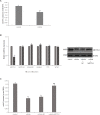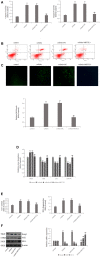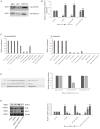METTL3/m6A/miRNA-873-5p Attenuated Oxidative Stress and Apoptosis in Colistin-Induced Kidney Injury by Modulating Keap1/Nrf2 Pathway
- PMID: 31156435
- PMCID: PMC6530351
- DOI: 10.3389/fphar.2019.00517
METTL3/m6A/miRNA-873-5p Attenuated Oxidative Stress and Apoptosis in Colistin-Induced Kidney Injury by Modulating Keap1/Nrf2 Pathway
Abstract
Nephrotoxicity of colistin is the major factor limiting its clinical application. However, the exact mechanism of colistin-induced nephrotoxicity is still elusive. N6-Methyladenosine (m6A) modification has been implicated in many biological processes, however, its role in colistin-induced nephrotoxicity needs to be elucidated. Mouse renal tubular epithelial cells (mRTECs) were treated with 200 μM colistin with or without METTL3 overexpression. Cells injury, m6A assay, oxidative stress and apoptosis were examined. Levels of m6A are decreased after colistin treatment in mRTECs. METTL3 is the major factor involved in abnormal m6A modification. METTL3 overexpression plays a protective role against colistin-induced oxidative stress and apoptosis. Moreover, METTL3 interacts with the microprocessor protein DGCR8 and positively modulates miR-873-5p mature process in an m6A-dependent manner. Further experiments show that miR-873-5p could regulate Keap1-Nrf2 pathway against colistin-induced oxidative stress and apoptosis. These studies revealed an important role of METTL3/m6A in colistin-induced nephrotoxicity and provide a new insight on m6A modification in drug induced toxicity.
Keywords: apoptosis; colistin; m6A modification; miRNA; oxidative stress.
Figures






Similar articles
-
METTL3-mediated M6A methylation modification is involved in colistin-induced nephrotoxicity through apoptosis mediated by Keap1/Nrf2 signaling pathway.Toxicology. 2021 Oct;462:152961. doi: 10.1016/j.tox.2021.152961. Epub 2021 Sep 21. Toxicology. 2021. PMID: 34560125
-
METTL3 contributes to slow transit constipation by regulating miR-30b-5p/PIK3R2/Akt/mTOR signaling cascade through DGCR8.J Gastroenterol Hepatol. 2022 Dec;37(12):2229-2242. doi: 10.1111/jgh.15994. Epub 2022 Sep 18. J Gastroenterol Hepatol. 2022. PMID: 36068012
-
MicroRNA-140-5p attenuated oxidative stress in Cisplatin induced acute kidney injury by activating Nrf2/ARE pathway through a Keap1-independent mechanism.Exp Cell Res. 2017 Nov 15;360(2):292-302. doi: 10.1016/j.yexcr.2017.09.019. Epub 2017 Sep 18. Exp Cell Res. 2017. PMID: 28928081
-
METTL3 plays multiple functions in biological processes.Am J Cancer Res. 2020 Jun 1;10(6):1631-1646. eCollection 2020. Am J Cancer Res. 2020. PMID: 32642280 Free PMC article. Review.
-
Multiple Functions and Mechanisms Underlying the Role of METTL3 in Human Cancers.Front Oncol. 2019 Dec 12;9:1403. doi: 10.3389/fonc.2019.01403. eCollection 2019. Front Oncol. 2019. PMID: 31921660 Free PMC article. Review.
Cited by
-
METTL3-mediated m6A mRNA contributes to the resistance of carbon-ion radiotherapy in non-small-cell lung cancer.Cancer Sci. 2023 Jan;114(1):105-114. doi: 10.1111/cas.15590. Epub 2022 Oct 9. Cancer Sci. 2023. PMID: 36114749 Free PMC article.
-
METTL3 m6A-dependently promotes miR-21-5p maturation to accelerate choriocarcinoma progression via the HIF1AN-induced inactivation of the HIF1A/VEGF pathway.Genes Genomics. 2022 Nov;44(11):1311-1322. doi: 10.1007/s13258-022-01309-x. Epub 2022 Sep 8. Genes Genomics. 2022. PMID: 36074324
-
Regulation of N6-methyladenosine (m6A) RNA methylation in microglia-mediated inflammation and ischemic stroke.Front Cell Neurosci. 2022 Aug 4;16:955222. doi: 10.3389/fncel.2022.955222. eCollection 2022. Front Cell Neurosci. 2022. PMID: 35990887 Free PMC article. Review.
-
Up-to-date on the evidence linking miRNA-related epitranscriptomic modifications and disease settings. Can these modifications affect cross-kingdom regulation?RNA Biol. 2021 Nov 12;18(sup2):586-599. doi: 10.1080/15476286.2021.2002003. Epub 2021 Nov 29. RNA Biol. 2021. PMID: 34843412 Free PMC article.
-
MiR-873-5p targets THUMPD1 to inhibit gastric cancer cell behavior and chemoresistance.J Gastrointest Oncol. 2021 Oct;12(5):2061-2072. doi: 10.21037/jgo-21-641. J Gastrointest Oncol. 2021. PMID: 34790374 Free PMC article.
References
LinkOut - more resources
Full Text Sources

